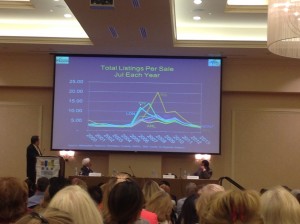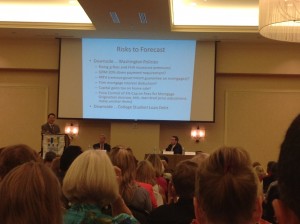Northern Virginia Association of Realtors Hosts 17th Annual Eco-Summit
Find out more about what is going on within our Northern Virginia economy, what it means for job growth, construction, multi-generational families and real estate in general through deep statistics and trending as discussed by four amazing national and hyper-local panelists at the seventeen annual Northern Virginia Association of Realtors Economic Summit. I will break down my many pages of notes and make sense for you the information that the Realtor’s Association, Builder’s Association and statisticians delivered which impact our Northern Virginia real estate market and economy. – Genevieve Concannon
 Thursday, September 5th, The Northern Virginia Association of Realtors hosted its seventeenth Annual Economic Summit, or Eco-Summit as they call it; this title really seems like it is going to have something to do with the environment because of the “eco” term, but no. It is about the economy- mostly regionally but a bit about the National situation as well. Maybe that does have some sort of connotation to the environment- the just the economic-environment.
Thursday, September 5th, The Northern Virginia Association of Realtors hosted its seventeenth Annual Economic Summit, or Eco-Summit as they call it; this title really seems like it is going to have something to do with the environment because of the “eco” term, but no. It is about the economy- mostly regionally but a bit about the National situation as well. Maybe that does have some sort of connotation to the environment- the just the economic-environment.
A Fine Selection of Panelist
A very richly appointed panel of speakers and experts was on hand for this years discussion from Kenneth Harney of the Washington Post to the Senior Vice President of the National Association of Home Builders, Dr. David Crowe. Even George Mason University’s David Versel who acts as Senior Research Associate gave some valuable insights to the region’s economic climate. The panel was nicely rounded out by the National Association of Realtor’s Chief Economist, Dr. Lawrence Yun, whom is not only highly informative, but also comedic. Who knew? Now NoVa’s Finance and Settlement’s panelists and their Summit attendees do; Yun, Crowe and Harney could have a sketch comedy night with their banter.
Spanning QM to Immigration
Everything from Fannie and Freddie’s impending doom to the discussion of QM mortgages and the rebound moving into its second phase were discussed by panelist. Kenneth Harney opened up the discussion by warming the hearts of the room: … “NOVA as a fortunate market”… he said as he navigated the idea that the DC Metro area has been the least struck by the recession. Versel then transitioned the discussion into hard statistics and figures about the procurement sector and how housing is majorly going to be affected by boomers not selling; he believes that they will want to age in place and even bring in all of their family and children and have more mulch-generational family systems. His mindset is that those who are in the suburbs will stay in the suburbs. It might be a sustainable practice, and then who will fill in that gap? Yun opined that the immigrant population actually fills in for those Gen X, Gen Y and even Millienials who are opting to rent rather than buy. It is an interesting concept, but seems to be true, especially in the DC Metro area.
Growth in the Recession
Enter Dr. Crowe, of the NAHB to discuss the “lateness” of builders in the nation and especially hyper-locally in the DC Metro  area. Multifamily development has picked up, but single family home building has not, because of a lack of skilled labor and price increase across the board of materials. The very interesting thing is that new construction should have been feverishly fueled by the extreme lack of inventory as referenced by Versel and his statistics. When Dr. Yun made his final points to the room, he referred to the low inventory, the low interest rates, that is is cheaper in the DC Metro area to buy than to rent because of ever increasing annual rental rates and that the DC Metro area had experienced and enjoyed the local area’s economy rising about 3% in the next year, which is double than the national average, even with sequestration in effect. Yun also made reference to the phenomena of “clustering impact” (when many people move to one area and all need a place to live and work) that this can lead to job creation- he thinks that it can be seen in this DC Metro area as it was seen and identified in the San Francisco area when people moved to the Silicon Valley for startups. People come to the area and create jobs- knowing that there is skilled labor and then jobs and homes just magically manifest… no- they are created out of necessity.
area. Multifamily development has picked up, but single family home building has not, because of a lack of skilled labor and price increase across the board of materials. The very interesting thing is that new construction should have been feverishly fueled by the extreme lack of inventory as referenced by Versel and his statistics. When Dr. Yun made his final points to the room, he referred to the low inventory, the low interest rates, that is is cheaper in the DC Metro area to buy than to rent because of ever increasing annual rental rates and that the DC Metro area had experienced and enjoyed the local area’s economy rising about 3% in the next year, which is double than the national average, even with sequestration in effect. Yun also made reference to the phenomena of “clustering impact” (when many people move to one area and all need a place to live and work) that this can lead to job creation- he thinks that it can be seen in this DC Metro area as it was seen and identified in the San Francisco area when people moved to the Silicon Valley for startups. People come to the area and create jobs- knowing that there is skilled labor and then jobs and homes just magically manifest… no- they are created out of necessity.
Standing out in the Crowd
Yun discussed one county stood out among the rest thirty years ago- Montgomery County. Maryland… everyone wanted to live and work there. Now it is Fairfax County; the nation’s most affluent county, that people would like to live and work. More people are moving FROM Montgomery Co. to Fairfax Co! Isn’t that special? NoVa is benefiting from this shift as a whole- job  creation and housing as well. If there is no new construction for people to move up… this is a problem. Where are people going to “move up” to if they need to have a larger family space? This is where Dr. Crowe interjected the new-urbanism concept of building up and the multi-family condo necessity in dense urban areas. Some people wanted to know why condominiums aren’t appreciating as quickly as single family homes; that happens to be because of mortgage lending requirements.
creation and housing as well. If there is no new construction for people to move up… this is a problem. Where are people going to “move up” to if they need to have a larger family space? This is where Dr. Crowe interjected the new-urbanism concept of building up and the multi-family condo necessity in dense urban areas. Some people wanted to know why condominiums aren’t appreciating as quickly as single family homes; that happens to be because of mortgage lending requirements.
There are so many facets to the economic outlook of the home building and housing industry, it could have been a week long summit, but this was just a few hours with a few very knowledgeable gentlemen.
Apparently the DC Metro area and Northern Virginia can be grateful that even during an economic downturn and with sequestration in place, home ownership is still a valued and sought after priority in most American’s lives. Now, we just need to know how to serve those who are undeserved and or are on the cusp of renting or buying and the idea of creating wealth. That’s for another time.
